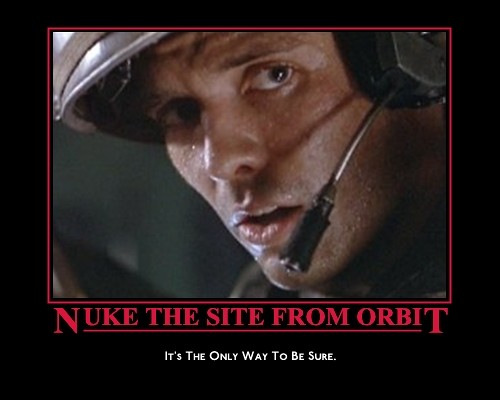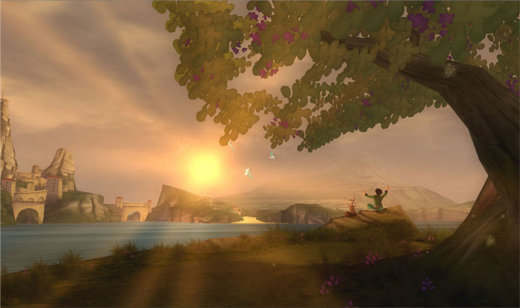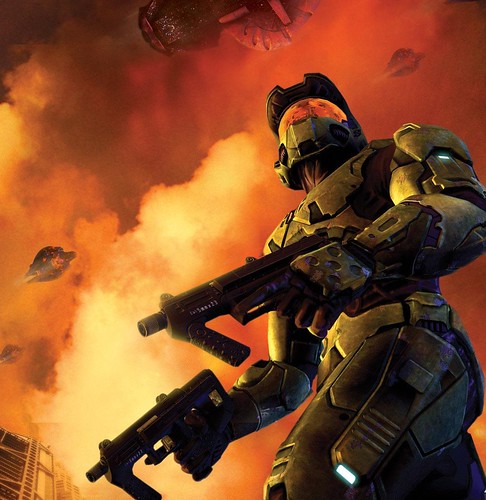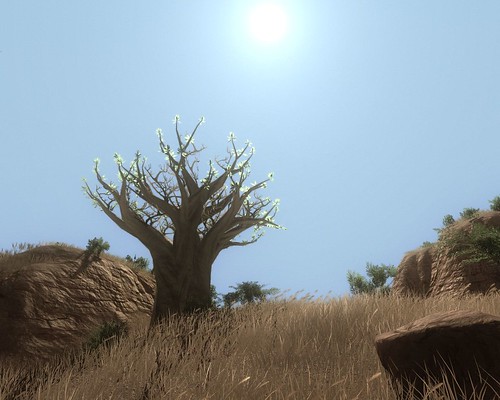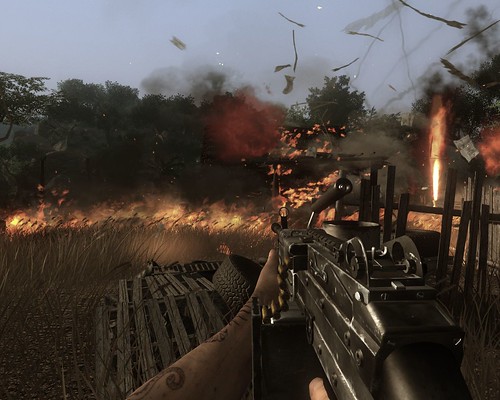
I love Far Cry 2. You want to love Far Cry 2, but you’re always getting killed, then getting rescued by your buddy only to get killed again a mere minute later. So here is SLRC’s top 5 tips on How To Kill People More Effectively In Far Cry 2. Inspired by Steve Gaynor’s post ‘Basics of FPS encounter design’, because Far Cry 2 is both the epitome of good FPS encounter design, and its antithesis.
#1 – Distance is the man killer, and you are the man.
If there is only one thing you learn about playing Far Cry 2, it should be that the distances involved in any engagement are an order of magnitude higher than any other game around. The sprawling African savannahs allow for you and your enemies to trade potshots at targets up to a kilometer away – and still retain reasonable chance of hitting.
Long range weaponry is king in Far Cry 2 and ideally you want to have at least one weapon with a scope on it at all times. Why? Because your enemies are better than you, can see through the brush and scrub better than you and there are just plain more of them. The more distance you can create between yourself and your target, the less likely they are going to be able to land any hits on you (especially if they are wielding shotguns, LOL!).
However, we here at SLRC know that ideal isn’t always possible, as you will probably eventually run out of bullets from killing so many people. In that case, you’re going to have to close to a middle distance and change to an alternative weapon. Note however, that I have never on a difficulty harder than normal been able to fight closer than 50 yards and take no damage; the AI is just too fast and too accurate at point blank range. Be smart and Just Don’t Go There. Which brings us to point #2.
Pro Tip: If you get your angle right, and you are patient, you can often shoot two people with one sniper round! Brillantine!
#2 – Pick where YOU want to murder people, don’t let them decide where you are going to die.
If your enemy doesn’t know you are there, you have the advantage of time, as well as space. Use it. Choose both where and when to engage. If possible, follow point #1 and fight from as far away as possible. For arguments sake, however, lets pretend you don’t have any sniper weapons or (more likely) you’re out of bullets from killing all those naughty mercenaries. Sometimes you need to get up close and get your hands dirty.
The main thing to look for is cover – learn to read the environment and look for things that you can potentially stand behind and that won’t let bullets through. If the obvious approach to a position doesn’t look like a good idea, it probably isn’t – don’t risk it. Swing around and come at them from the side, or even better, from behind. There’s usually a multitude of options in Far Cry 2, so explore them. That stand of trees off to the right looks OK, but further to the North West there is a burnt out car, which is even better. The bigger the cover the less bullets you’ll be pulling out of yourself. Higher ground is always a good idea, too.
Since Far Cry 2 utilizes a semi-recharging health system, getting behind cover even when lightly wounded is absolutely critical unless you want to burn through syrettes like a morphine addict on a week long bender. It becomes an issue particularly on the higher difficulties where you can only carry 3 on you at all times (without buying an expensive upgrade for more) and is compounded when you’re trying to save some for when you buddy gets injured. Defensive play is often necessary at medium-close range, and that’s only possible if there’s plenty of cover – the enemy can and will flank you and you will die.
Pro Tip: If your enemies are in cover and you are standing in an open field, you’re probably already dead.
#3 – Know your escape route and when to GTFO.
This ties in with point two, because if anything at all goes wrong, you will need a plan to get out of there and the faster the better. If an engagement has a chance of going hairy, SLRC personally like’s to park it’s car facing in the direction I know I’ll be wanting to escape and it has been useful on more than one occasion. An anecdote:
Once, on a mission to assassinate a prominent member of a faction, I parked my jeep on a large hill to the west of my target. A huge grassland area with no cover stretched between me and a number of his body guards. I parked my jeep facing south-west and started picking off mercenaries. They swarmed at me like I’d disturbed an ant hill, and I cut off their direct approach to me by starting a fire in the grass between me and them. However, as fire likes to travel uphill and it quickly turned on me meaning I had to GTFO as the ground caught fire beneath me. Thanks to having my jeep parked already facing the way to go, when I got in I was able to move in a safe direction and get out of the fire without taking much damage at all.
Often times, however, it will be the caser that your vehicle will be destroyed or disabled when you need to GTFO. In that case, sprint is your friend – learn where the sprint key is and the sprint-crouch move which allows you to slide the last few meters along the ground and into cover. It may just save your life!
Pro Tip: Your vehicle can be a valuable source of cover for your pathetic, bleeding figure as you limp off into the jungle.
#4 – Start a fucking fire.
I’m tempted to leave this point as-is, because it really is as simple as that. The effect of a nearby fire on an enemy is described by the Far Cry 2 fire propagation expert, Jean-Francois Lévesque (who is on twitter, incidentally), in an interview on Gamasutra.
Speaking in RPG terms, the fire acts as an area of effect fear spell.
Life forms will flee or at least try to avoid fire. It disorients the AI, making enemies forget about you and focus on saving their own skin. It gives you an advantage against high numbers of opponents.
Before, during and after anything goes wrong in your fight you should be thinking about starting some kind of fire. You always have on you two Molotov cocktails available for throwing and there are often many things you can shoot to blow up to start fires too. Make use of them all - anything to get those bastards to stop shooting at you!
Pro Tip: Despite the fact that it’s an extremely cheap weapon from the Gun Merchant, the flare pistol combines points 1 and 4 from this guide! Don’t underestimate the potential in starting a fire exactly where you want it, really, really far away.
#5 – Don’t use someone else’s gun, keep yours clean and don’t run out of ammo.
Weapon deterioration is a big part of Far Cry 2 as anyone that’s played for more than an hour or so can attest. So make sure to visit the weapon dealer regularly to pick up a free new gun – remember, if you’ve unlocked it you can get new ones whenever you like for no additional cost! Isn’t that handy?
When you run out of sniper ammo, the LAST thing you want to do is ditch you gun for (to quote Danny Archer from Blood Diamond) some “rotten AK” which is going to jam on you when you least need it. A better idea is switching to a secondary or special weapon, until you find an ammo box or crate.
Pro Tip: A big-ass machine gun in your special weapon slot is a very good idea for when you can’t use your sniper rifle, and when your pistol is a flare gun. As much fun as it is to light men ON FIRE with the flare gun, it’s pretty dangerous and SLRC does not recommended it.

